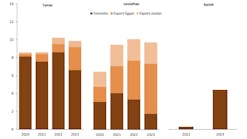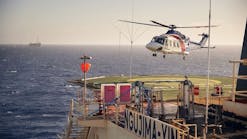Turnkey package features large, small versions
Nick Terdre
Contributing Editor
- Sketch of the large version of Kockums/GVA-C turret, as intended for heavy-duty FPSOs. [30,027 bytes]
- The small version of the Kockums/GVA-C turret is aimed at FPSO conversions for service on marginal fields. [39,567 bytes]
The first contract could be won in the not too distant future, as the joint venture is already bidding for projects in the North Sea and Gulf of Mexico. The line-up contains a strong element of Swedish marine expertise - GVA Consultants and Kockums are both part of the Celsius group. Together, the partners will provide a package which includes subsea facilities, pipelines and risers, and the turret and mooring system. Such a package is expected to prove an attractive proposition in a market in which the numbers of FPSOs, both newbuild and conversions, are forecast to continue growing rapidly around the world. "The market is asking for this," says Per Ekehorn, general manager for GVA International. "We're getting a very positive response at the company presentations we're doing."
CSO will be responsible for engineering, supplying, and installing flexible risers, umbilicals, the mooring system and other subsea products, while GVA-C and Kockums contribute their turret design expertise. Kockums could also fabricate the turrets. GVA-C's role will also include mooring analysis.
GVA departure
For GVA-C, a world-class designer of semisubmersible drilling rigs and production platforms, the move into FPSO technology appears to mark a new departure. It has however worked on and off on turrets for 10 years, according to Ekehorn, and more intensively in recent years as FPSOs have become a leading production facility. Approval in principle already has been given for the turret design by Lloyd's Register. Designs have been developed for both large and small diameter turrets. The large is intended for heavy-duty newbuildings with a service life of 25-30 years and the small for converted units likely to be working on marginal fields, according to Ekehorn. Typical dimensions for a large turret would be 16 meters in diameter and 2,000 tons in weight, and for a small turret, 6 meters and 1,000 tons.The design is fabrication friendly, calling for conventional shipyard practice only. The turret well in the vessel, within which the turret sits, has an octagonal shape, again making for ease of fabrication compared with the more usual circular design.
The design is well suited to harsh environments such as the Atlantic Frontier. It is equally applicable to deep and shallow-water conditions. The mooring lines are supported individually above the water-line, and mooring tension easily can be adjusted from the deck. For this purpose, the small diameter design includes a chain table and chain stoppers. The large design uses sliding bearings at the interface between turret and ship. The upper bearings, which are located at the upper deck level, consist of a polyurethane surface bonded to elastomeric pads on the ship, which interface with a compound steel surface on the turret.
Load off bearings
The polyurethane surface does not run round the whole circumference of the turret well, but is restricted to four discrete sections placed at equal intervals. The effect of this arrangement is that the bearing is less sensitive to loadings in the hull, Ekehorn explains.The lower bearings similarly use the same polyurethane surface on elastomeric pads, so that only one set of spare parts needs to be kept to cover the two bearings. For inspection and maintenance purposes each of the bearing elements easily can be removed and replaced. Full-scale tests of the bearing system have been performed at Kockums laboratory facilities in Malmo.
Because the use of sliding bearings means a higher coefficient of friction, the design also includes turning machinery to move the turntable back to a neutral position after the vessel has weathervaned.
A large number of risers can be accommodated within the turret. Fluid is transferred by means of flexible risers pulled inside individual guide tubes and flange-connected to manifold pipework leading to a swivel stake or drag chain. At present, a swivel or drag chain would be bought in, but it is possible that at some future date one of the suppliers of these products could be brought into the joint venture, Ekehorn says.
Copyright 1997 Oil & Gas Journal. All Rights Reserved.




